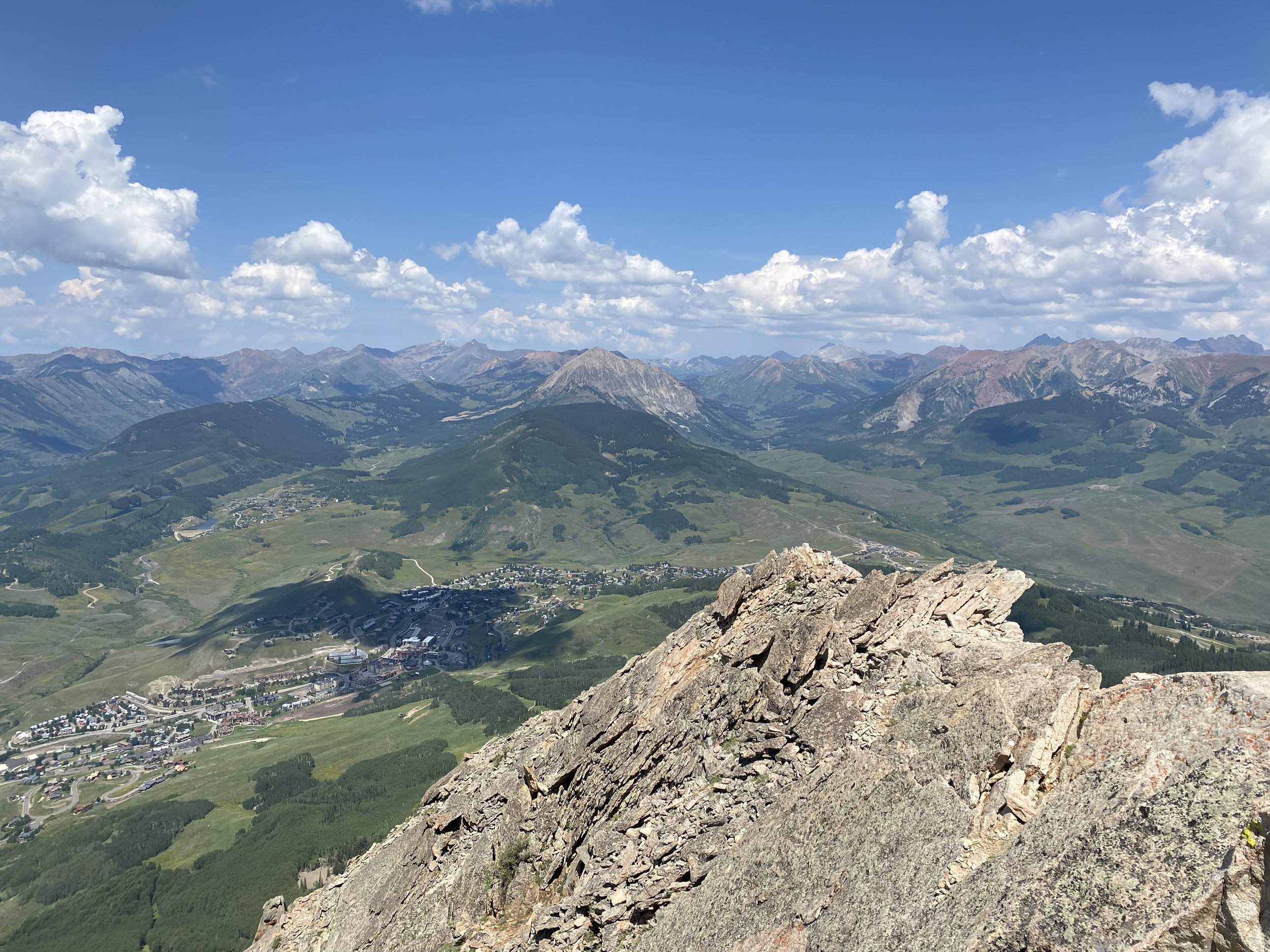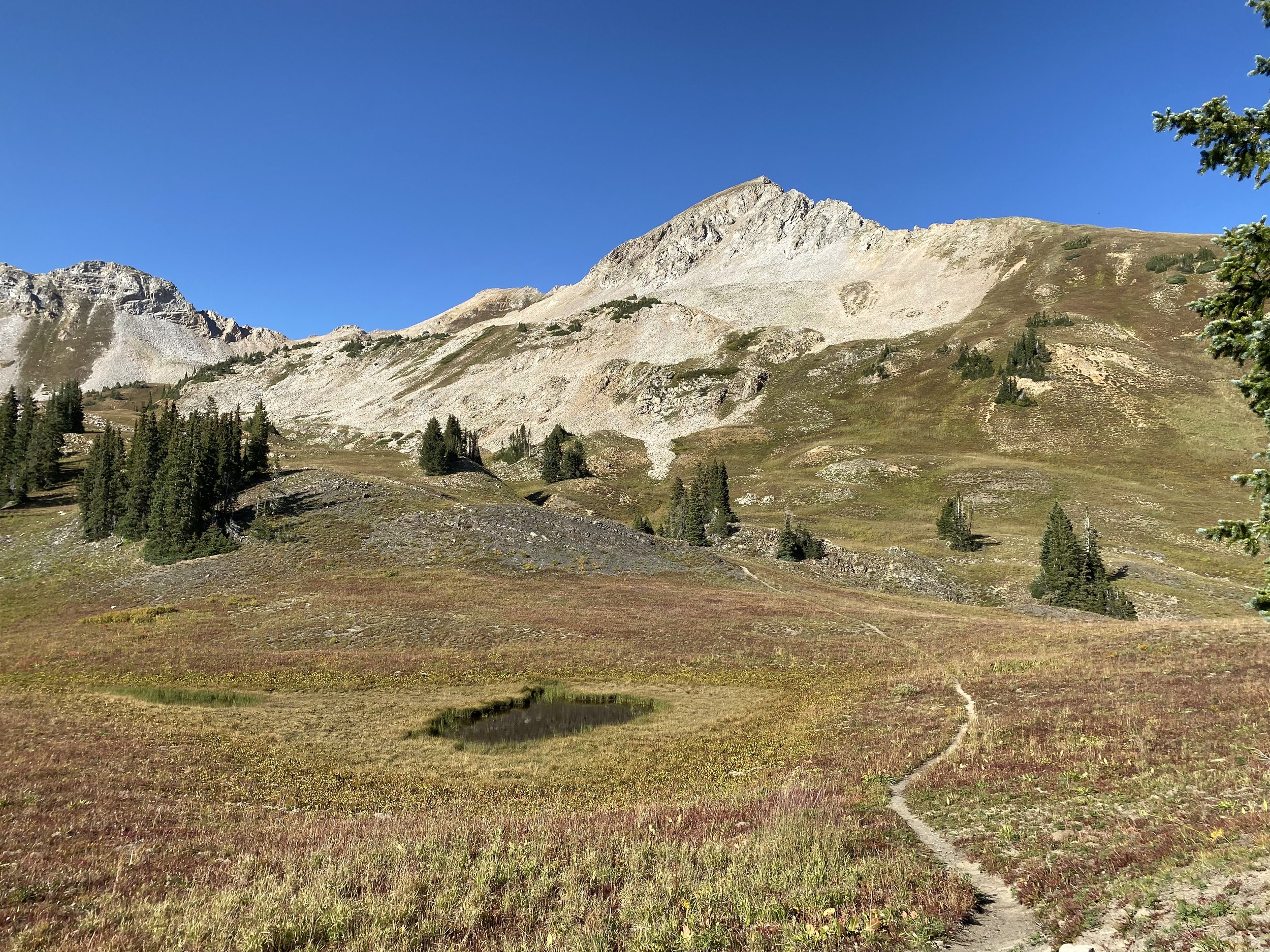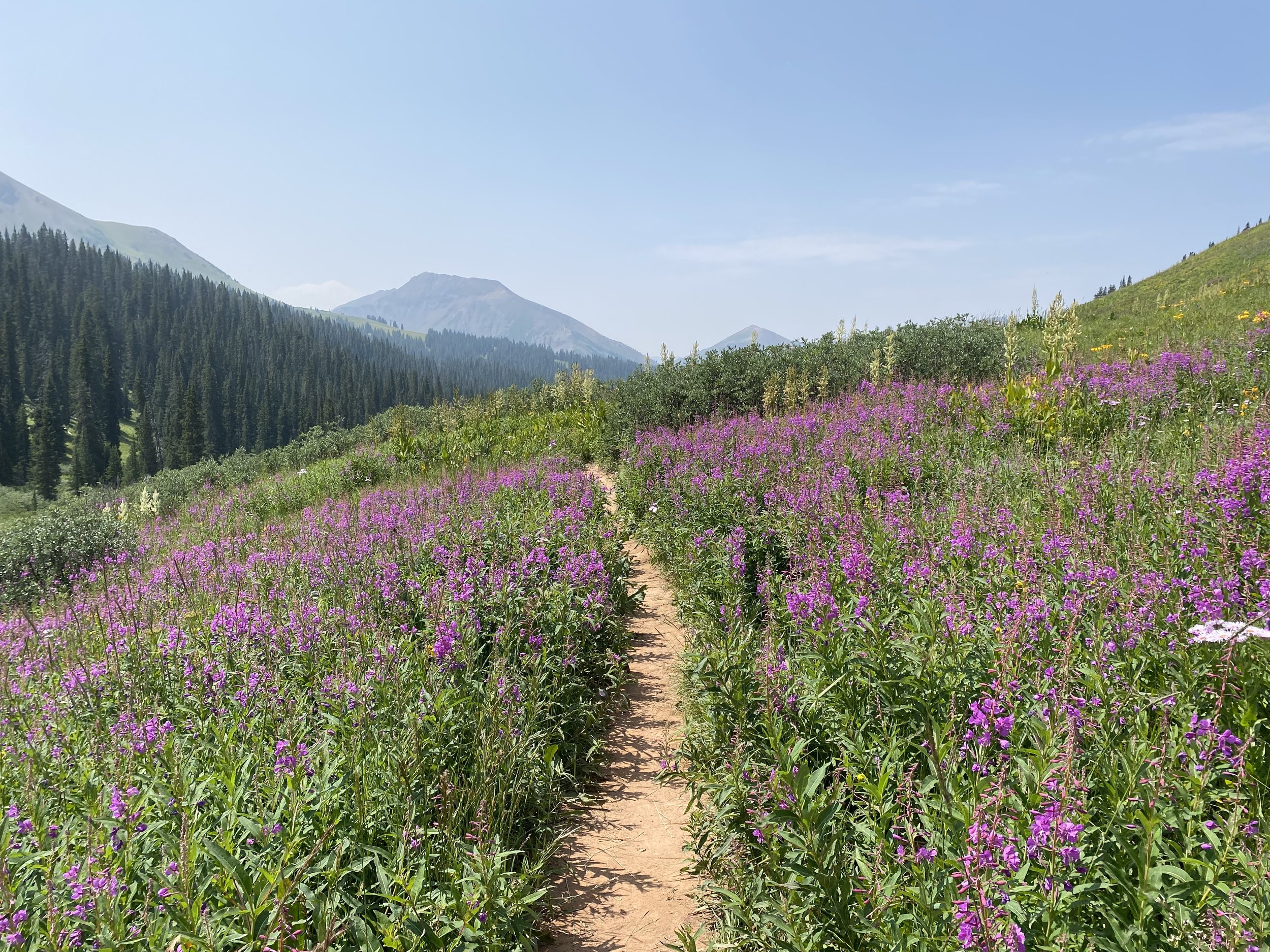Acclimatizing in Crested Butte: elevation 8,900ft
Denver may be a mile-high city, but the town of Crested Butte is more like a mile and a half.
View of the town of Mt. Crested Butte (9,375ft), from the summit of its name-sake (12,162ft) Traveling to Crested Butte, CO, from sea level requires planning and preparation.
If you’ve spent most of your life at or below 4,000ft, you should factor in time for your body to adjust in town, before attempting to do any strenuous activities in the mountains.
The risks associated with traveling too high, too fast, are Acute Mountain Sickness (AMS), High-Altitude Cerebral Edema (HACE), or High-Altitude Pulmonary Edema (HAPE).
There is no cure for AMS, HACE, and HAPE, besides returning to a lower elevation and giving your body time to recover.
How can you avoid developing AMS while visiting Crested Butte?
Acclimatization:
Ascend slowly; spend time adjusting to one elevation before continuing higher
Rest
Stay hydrated
Avoid consuming excessive amounts of alcohol
Pay attention to what your body is telling you
Speak up; if you feel poorly, say something
AMS is the most likely scenario when a person ascends too rapidly; HACE and HAPE are far more dire conditions, but also far less common.
Dawn near Capitol Pass (12,078ft), Maroon Bells-Snowmass WildernessWhat does AMS feel like?
Mild to moderate headaches
Fatigue
Dizziness
Dehydration
Difficulty sleeping
Shortness of breath
Rapid pulse
Nausea
Loss of Appetite
AMS can develop into a life-threatening condition if left unaddressed.
It is important to let the people you are traveling with know when you are not feeling 100%.
If you recently arrived in town and begin to experience symptoms of AMS, it would be wise to get some rest and drink lots of water; if the symptoms to do not resolve within 24hr, or they worsen, the safest course of action is to descend to a lower elevation.
The closest town to Crested Butte is Gunnison, elevation: 7,700ft.
Oxygen Bars and canisters may be a quick fix to for the symptoms of AMS, but not a longterm solution.
In Crested Butte, you will notice “oxygen bars” on Elk Ave, and oxygen canisters being sold in the local outfitters; while oxygen is a quick fix to the immediate symptoms of AMS, it is not a long-term solution.
AMS occurs not because the concentration of oxygen in the air is lower, it isn’t; we begin to feel poorly because the barometric pressure is lower, and so the quantity of oxygen we pull in with each breath decreases.
If given the opportunity, the body may adjust to performing well with less oxygen; the only way to truly acclimatize, though, is to give the body time at any given altitude, before ascending higher.
Altitude does not affect everyone to the same degree. Some individuals will not feel any different at 8,000ft than they do at sea level, and they may only feel a bit out of breath at 12,000ft.
Others will notice themselves feeling fatigued while grocery shopping, or walking from their car to their AirBnB.
It does not necessarily say anything about a person’s health if they find themselves struggling to catch their breath when they arrive to Crested Butte from a lower elevation.
While there are factors which contribute to a person’s ability to adapt to higher altitudes—such as the elevation where they live, or whether or not they have experience recreating at higher elevations—it is a toss-up, who will arrive to town well-adjusted and who will need time to acclimatize.
View of Whetstone, overlooking Skyland Resort (8,900ft), Crested Butte, COMy personal experience with AMS:
When I thru-hiked the Colorado Trail, I had an episode in Breckenridge (9,600ft) a week into my hike; I arrived hungry, dehydrated, and fatigued—my body already at a deficit—having felt completely fine on my trip up until that point.
My head started to spin and I was overcome with nausea. My skin felt clammy, my heart raced. All I wanted to do was lay down in a quiet, dark room.
My solution was to spend the afternoon rehydrating and resting at my hostel. The next morning, I woke up feeling better, if not a little tired, and I was able to keep walking.
The outcome for AMS is better if it is treated before symptoms escalate; it is not a condition one should “push through”, because, as a friend of mine from the Appalachian Trail used to say, “That’ll end your hike!”
Unnamed pass (~12,000ft), Maroon Bells-Snowmass WildernessWhat happens when AMS is left untreated?
If the symptoms of AMS go untreated (remember the treatment: rest, rehydrate, and descend), a person is at risk for developing HACE or HAPE, both of which are potentially deadly conditions that cannot be treated in a wilderness setting and would result in a person’s immediate evacuation to the nearest hospital.
HACE, or High-Altitude Cerebral Edema inhibits or reduces normal brain function, due to a buildup of fluid around the brain.
HAPE, or High-Altitude Pulmonary Edema results in decreased lung capacity and difficulty breathing, due to a buildup of fluid in the lungs.
Scary, right?
The most common setting for HAPE and HACE to occur is above 12,000ft, but people have been known to develop these conditions, in rare incidences, at elevations as low as 8,500ft.
Prolonged exposure to altitude is a critical factor in the development of these conditions; the typical onset for HACE occurs 5 days after arrival at a new elevation.
In short, these conditions do not suddenly manifest; the signs and symptoms of AMS appear as an initial warning and, if left unaddressed, could lead to the progressive deterioration of a person’s condition, until the situation becomes life-threatening.
The climb to Hasley Pass (12,120ft), Maroon Bells-Snowmass Wilderness When visiting Crested Butte, the likelihood of developing a life-threatening condition is slim.
But it is important to recognize the signs and symptoms of AMS, so that you can properly care for your body and enjoy your time above 8,900ft.
If you are considering signing up for a backpacking trip with She Treks in the West Elk Mountains, the highest elevation you may reach is between 11,050ft and 13,035ft, with prolonged exposure to elevations above 9,000ft.
It is so important to give your body time to adjust to higher elevations in a non-wilderness setting—24 to 48hrs spent in town, at least—before venturing out into a remote setting and continuing to ascend higher.
The basics to keep in mind? Avoid drinking alcohol, maintain good hydration, listen to your body, and rest.
Patience is key; AMS does not discriminate.
River Beauty near Schofield Pass (10,700ft)
Sources:
Peter H. Hackett, David R. Shlim, Centers for Disease Control and Prevention, accessed 22 May 2022, <https://wwwnc.cdc.gov/travel/yellowbook/2020/noninfectious-health-risks/high-altitude-travel-and-altitude-illness>
Rick Curtis 1999, Princeton University, accessed 22 May 2022, <https://www.princeton.edu/~oa/safety/altitude.html#:~:text=This%20process%20is%20known%20as,10%2C000%20feet%20(3%2C048%20meters)>
Luciano Bernardi 2012, Science Direct, accessed 22 May 2022, <https://www.sciencedirect.com/topics/medicine-and-dentistry/high-altitude-cerebral-edema#:~:text=Although%20HACE%20has%20occurred%20at,arrival%20at%20a%20new%20elevation>
Lois Zoppi, B.A. 2021, News Medical Life Sciences, accessed 22 May 2022, <https://www.news-medical.net/health/What-Makes-Different-People-More-or-Less-Susceptible-to-Altitude-Sickness.aspx#:~:text=People%20traveling%20to%20high%20altitudes%20who%20usually%20live%20at%20sea,partial%20pressure%20at%20sea%20level>






